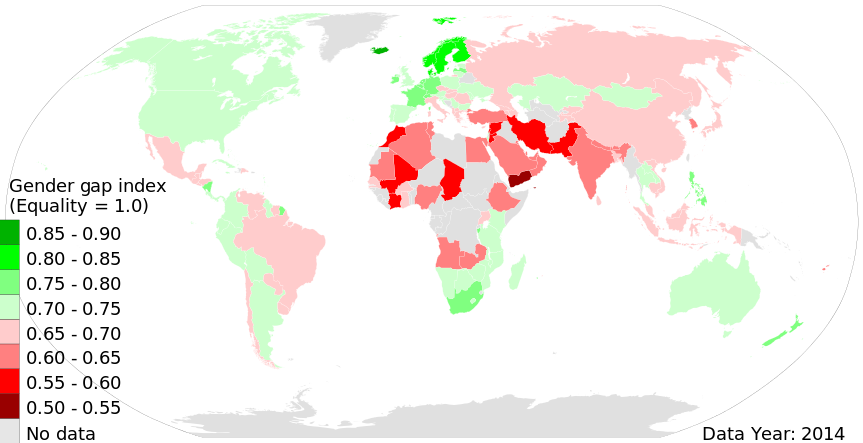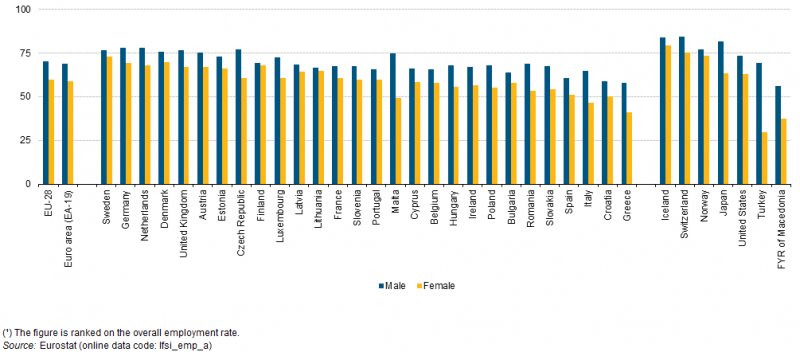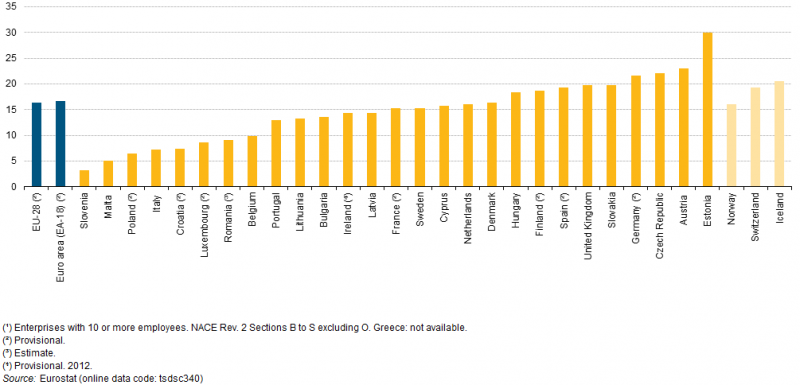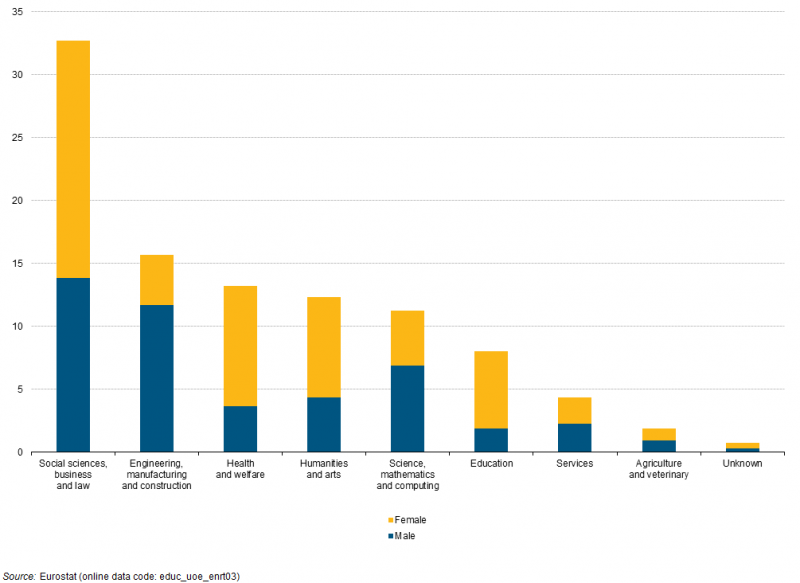Among liberal and conservative thinkers alike, feminism has a bad rap — a phenomenon for which there are many reasons. However, modern feminism, when conceptualized accurately and implemented in its truest form, might just be the key to solving numerous socio-political issues: for example, shortages of skilled workers, poverty among the elderly, and the transformation towards “knowledge societies.” But before diving into modern feminism, let’s explore what feminism is known for—and sometimes mistaken for—in my home country, Germany – a place with a long history of developing an equal society.
Feminism – The Big Bad Wolf?
When it comes to feminism—and many other topics—there are two main types of discourses: bar room debates and intellectual critique. Let’s address the latter so you can shine with new arguments in the former.
The critique of feminism consists of three main accusations:
1. Feminism leads to polarization, with women being the oppressed and systematically disadvantaged majority and men being the perpetrators and profiteers of said system. This polarization causes feminists to hate and fight men.
2. This polarization creates and reinforces dichotomous thinking, driving a wedge between the sexes and ultimately reproducing stereotypes that hinder automatic, natural progress towards gender harmonization.
3. The necessity for women to emphasize their role as society’s oppressed gender is a result of self-victimization – that is, women considering themselves to be inferior to their male oppressors. In fact, this is exactly what women are claiming not to be – a perfect catch-22 situation.
Before we address these valid concerns, let’s examine today’s understanding of feminism, as it is based on the Western experience.

This map shows the gender gap index, as calculated by World Economic Forum in its 2014 report. Gender gap index is a measure of gender inequality. Author: Tumless, source: Wikimedia Commons
Gender inequality refers to unequal treatment or perceptions of individuals based on their gender.
Living Modern Feminism
In the Western hemisphere, in countries such as Germany, feminism used to be considered a rebellious movement in eras when extreme actions were necessary to get the ball rolling. Now, the ball has been rolling for several decades, gaining momentum from such accomplishments as women’s rights to vote, obtain higher education, and enter male-dominated professional spheres.
Eventually, with motions such as women’s empowerment programs, people have realized that feminism can no longer be ignored. In fact, some people even fear that feminism threatens the livelihood of other members of society — for example, in the case of Germany’s quotas for women on corporate boards.
Post-Soviet men hopelessly outnumbered by women – explaining the gender gap in the ex-USSRhttp://t.co/PIQbiIDFEc pic.twitter.com/U5rDhmtHRq
— Business Ukraine mag (@Biz_Ukraine_Mag) August 17, 2015
These examples show that the advancement of women in society is often associated with the potential deterioration of their male counterparts’ status.
This is not what modern feminism is about! Modern feminism does not view politics, economics, or society as a zero-sum game. When women “win,” men do not automatically “lose.”
The biggest misconception about modern feminism that we also encounter in Germany is that it is only targeted at women. In fact, modern feminism helps not only women, but also men, people of color, LGBTQ people, people with disabilities, people of different ages, and even families. But how can something that is seemingly so specific be so beneficial to virtually everyone?
Modern feminism rests on two premises:
1. People are first and foremost individuals with different interests, ideas, and capabilities. They are only united by their wish to express themselves freely and to be accepted for who they are.
2. Traditional societal roles (whether they relate to gender, age, or any other characteristic) lead to certain expectations and judgments regarding behavior, which limit a person’s freedom to exercise his or her individuality.
Here is an example to illustrate these grounds: traditionally, a woman’s role in society is to at some point to become a mother and take care of her children. Meanwhile, the traditional role for men is to take care of the family financially while the mother devotes her time to their offspring.

Employment rate of women in EU, age group 20-64, 2014. Source: Eurostat, Online Data
Consequently, society expects women to put their careers second to their family and men to do the opposite. If individuals choose to take a different path—whether for personal, financial, religious or other reasons—they are likely to be judged as bad mothers or lazy fathers. In order to avoid social stigma—and the possible economic backlash that can result—men and women often stay within the socially confining boundaries of their traditional gender roles.

Gender pay gap in unadjusted form, 2014. Source: Eurostat
Is that a bad thing? Not necessarily. If a family chooses to partake in traditional gender roles because it feels right to them, then there is no problem. This is because people can still stay true to their personal interests, ideas, and capabilities. But what about when a woman has a higher level of education and may be better suited than her partner to financially support the family?

Share of women among tertiary students in science, mathematics and computing – engineering, manufacture and construction (%), 2012. Source: Eurostat
Or, what if both partners want to spend an equal amount of time raising their child together, rather than one of them working full-time and missing the baby’s first steps? What if the partners are separated? What if the partners are not male and female, but a same-sex couple? What if the family also consists of members from older generations that need to be cared for?
In the Western liberal states— and increasingly in Eastern countries as well— domestic patterns of the past are receding, giving way to a potpourri of new family models. These developments require nuanced solutions, and therefore flexibility and cooperation on a larger scale. Moreover, this is not only true of families. If everyone were empowered to choose their own path regardless of social expectations and judgments (assuming they are not physically or psychologically harming anyone), the promises of a liberal society could potentially be delivered.
How Modern Feminism Can Serve All
Modern feminists in Germany and beyond address those three points of critique mentioned earlier and approach structural deficits by focusing on the power of the individual. What exactly does this mean?
1. Modern feminism does not automatically assume that women are oppressed by or worse off than men, and therefore neither seeks nor wants to profit from gender polarization.
Instead, modern feminism acknowledges that there are a multitude of social groups with special interests and needs, which often differ at the individual level. As individuals, we can be both oppressed and oppressors. It is crucial that we as individuals carry responsibility for our behavior, rather than hide behind the traditional trappings of our social group.
2. Modern feminism does not reproduce stereotypes because it focuses on individuality.
By acknowledging, understanding, and accepting individual life choices—whether they adhere to or completely oppose traditional expectations regarding gender (or age, ethnicity, sexuality, etc.)—we dismantle dichotomous gender roles. Stereotyping—which to some degree is a natural neurological process for simplifying behavioral choices—should not entail expectations and judgments based on gender, age, ethnicity, sexuality, etc.. Rather, modern feminism acknowledges an individual’s group membership while respecting their behavior independently of societal expectations.
3. Modern feminism is not based on self-victimization, but self-empowerment.
As stated before: modern feminism is not about groups, but about individuals peacefully coexisting in one society. As such, modern feminists consider empathy to be the key to achieving this state. Moreover, it is not only the members of the “privileged” or “advantaged” groups that must demonstrate empathy towards those who appear less fortunate. For example quotas for women, people of color, older people, or members of other marginalized groups do threaten the status quo and may therefore cause anxiety. However, being sensitive to one another’s ideas, feelings, and interests, and accepting them to be just as legitimate as one’s own—independently of perceived group membership—will build bridges over existing rivers of separation.
Modern Feminism – Is it For Real?
Alright, you may be thinking, these are some nice words. But how do we apply these concepts to real life? Here are three simple steps that I try to incorporate into my everyday life in Germany to become more aware of and empathetic towards people from other backgrounds. (Maybe they can inspire you to try some of them in your everyday life, too.)
1. Asking and really listening
As an educated woman, for example, I can ask a shop clerk or someone else with a different ethnic background about their lives, ideas, and aspirations. I am often surprised to find that my own expectations for their answers are completely incorrect. Regardless of their background, l often find that most people have very similar needs – which is what unites us as humans.
2. Getting smart
Additionally, I read up on literature to better understand the mechanisms behind “social norms,” “othering,” and “discrimination,” to name a few relevant concepts. Sometimes it is easier to see what’s going on in the world when we are more aware of a phenomenon’s existence and functionality. Engaging with the topic will help train your mind and body to recognize situations in which people are prevented from expressing their individuality due to stereotypes or traditional roles.
3. Empathizing and speaking up
Once I recognize these situations, I think about how I would feel if I were in the discriminated person’s shoes. Understanding that I could just as well be the next target for discrimination, I try to become an advocate for the equality of everyone. Of course, I do not want to speak on another person’s behalf uninvited. However, I also know that if I were the victim of discrimination, I would appreciate it if someone else summoned the courage to voice their disapproval. This might even inspire other bystanders who are too afraid to speak up to be more courageous the next time they witness discrimination, thus creating a butterfly effect of empathy.
Summary
In the near future, we’d like to explore some pan-European but also local transformative initiatives in more detail. We will examine the movements’ models for societal alternatives, as well as their methods for achieving them. Our goal is to identify and share sources of inspiration for regional and global change.
Follow #commoneurope
